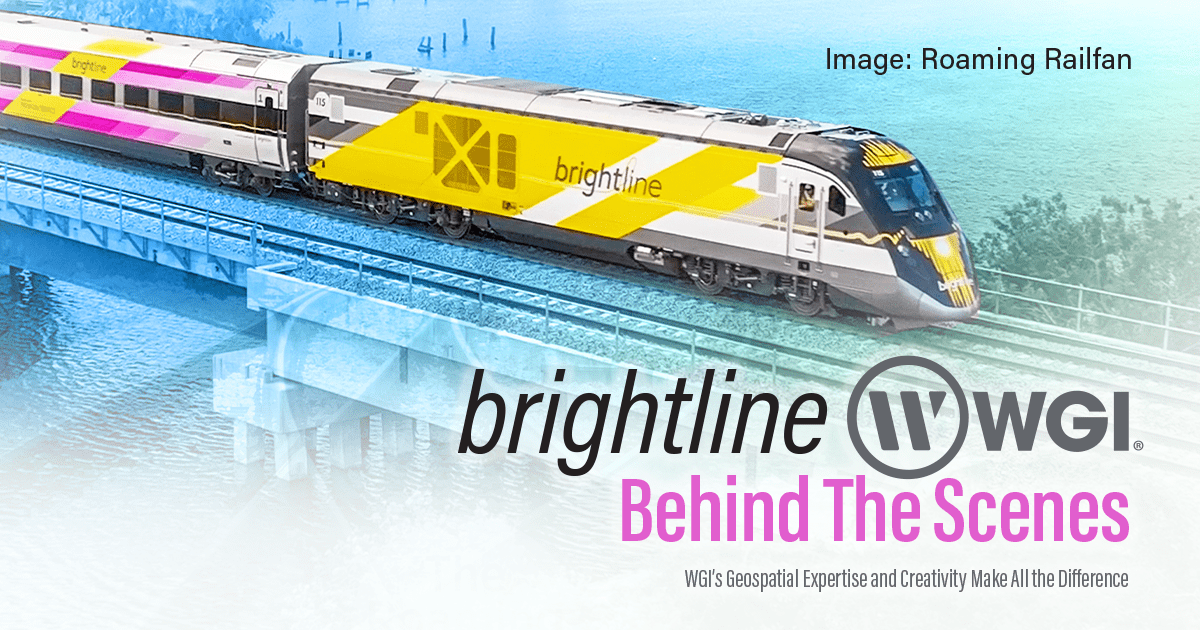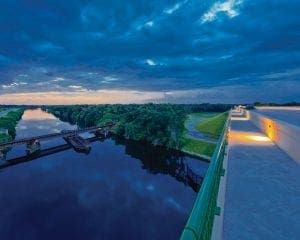
WGI’s Barbara Stiles, FSMPS, CPSM selected as the WTS Central Florida Woman of the Year
This award honors a woman who is an outstanding role model and has contributed to the advancement of women and minorities in transportation.
Learn from award-winning professionals — explore our whitepapers, blogs, and the latest industry updates.
Join our dynamic organization of engineers, land surveyors, landscape architects, environmental scientists, and architects!
Talk to a market leader today! We’ll answer any questions you have about our professional services.

On large and complex engineering and infrastructure projects, it’s often the less visible behind-the-scenes work that makes the biggest difference in a project’s success. WGI’s award-winning geospatial work on the Brightline High-Speed Rail project illustrates the important role of geospatial expertise in any complex project. It also demonstrates how talented and creative geospatial professionals provide innovative solutions to complex engineering challenges that improve development processes, avoid project delays, and significantly reduce project costs.
High-speed rail promises to transform rail transportation in the United States, and high-speed rail lines are planned for most of the East Coast, much of the Midwest, and significant parts of the West Coast. The 2021 Bipartisan Infrastructure Law provided more than $6 billion in funding for several of those projects. The first of the highly anticipated high-speed rail lines developed was the Brightline High-Speed Rail project. WGI’s geospatial team played a critical role in the project’s success by creating and implementing several key innovations.
Brightline is the first privately owned high-speed rail project in the United States, and the first private rail project of any type in over a century. The rail line provides service from Miami to Orlando, with an additional section extending service to Tampa under development. The landmark project has had an extraordinary impact on both the economy and the environment, and it is expected to inject $6.4 billion into Florida’s economy by the end of the decade. Brightline will also remove 3 million vehicles from local highways and roadways each year as commuters turn to high-speed rail transportation rather than driving their personal vehicles. This will translate to a reduction in greenhouse gas emissions of approximately 13.8 million metric tons of carbon dioxide every year.
WGI’s geospatial division served as the sole geospatial consultant for phase four of the Brightline High-Speed Rail project, which extended from West Palm Beach to Cocoa. In our role as geospatial consultant, WGI utilized GIS and technical approaches to collect and analyze essential geographic data for the project’s entire construction team, which involved dozens of subcontractors. This project included the installation of a 130-mile dual-track corridor to serve Class 6 rail, with a cruising speed that can reach 110 mph. In addition to two modern LEED-certified train stations, this project section also includes 155 at-grade crossings and 28 bridges over Florida’s coastal waters.
A project this large in scope was extremely complex, and WGI’s role was crucial. It was also instrumental in assuring that the project was completed quickly and at a significant cost savings. Because we have a large team of accomplished and experienced geospatial professionals, we were able to service the entire stretch of construction and all subcontractors simultaneously. Because of the efficiency of our in-house team, the project experienced no significant delays and construction proceeded seven days a week.
Timing and cost are always essential considerations on any project, and timing posed additional challenges for the Brightline development team. The COVID-19 pandemic struck in the middle of the project, which initially caused significant delays because of supply chain interruptions for construction materials. Additionally, costs for construction materials skyrocketed during the pandemic.
WGI was instrumental in mitigating those increased expenses and time challenges by introducing efficiencies that dramatically reduced costs and sped up the construction process.
Our geospatial experts reduced costs and delays by applying several groundbreaking innovations. The complexity of this project required WGI to implement several different types of data-collection technology on separate program elements. These technologies were applied in an innovative manner and the WGI geospatial team created several new processes.
The first of these innovations was part of WGI’s essential role of monitoring bridges for settlement along the construction corridor, making sure construction didn’t impact existing bridges. Work couldn’t start until each day’s measurements were completed and, initially, they were manually completed. This took over an hour each day, causing serious delays to the construction process. One of WGI’s most important innovations was the establishment of robotic monitoring stations armed with cellular connections, which reported the necessary measurements every hour, 24 hours a day. Altogether, nine mobile robotic monitoring systems were established, each utilizing specialized measurement equipment powered with solar panels, to monitor all 28 bridges that were under construction. The nine systems were utilized simultaneously each day and shifted among sites as needed.
By providing around-the-clock measurements, this automated approach eliminated the delays caused by manual measurement and provided an extra two-plus hours of construction time per day. This also provided significant safety benefits because team members didn’t have to go out onto tracks or rails to take measurements. The precision of the measurements also promotes safety in the ongoing operation of the railway.
A second, related innovation was the development of a specialized software suite that generated the hourly measurement emails to the client and the rest of the construction team. The complexity
of this project required WGI to implement numerous collection technologies to support the various program elements. These technologies were applied in an innovative fashion that significantly reduced project costs and duration.
WGI was challenged with coordinating the needs of multiple specialized contractors responsible for construction of the rail and bridges, while balancing track protection. In response, WGI developed the Work Order Tracking System (WOTS), a web-based tool which organizes the incoming work request scope, location, crew needs, schedule, rail protection, and specialized equipment. The survey team developed daily work packages for field teams, based upon the incoming needs of the various project managers and contractors, to balance specific needs across the entire team and schedule necessary internal staff and subconsultant protection details. WOTS provided real-time performance metrics of task scheduling to determine critical path elements, schedule slippage, and whether information was lacking from the requestor. In addition to supporting WGI’s office technical staff and field crew scheduling, WOTS even supported timesheet and billing reconciliation to support our client’s submittals to the owner.
The impact of WOTS on the Brightline project was so extraordinary that our firm is implementing it throughout our organization. WGI now employs this groundbreaking technology to manage work packages and schedule more than 25 field crews each day.
A third innovation was the implementation of a manually operated trolley equipped with data-collection software to measure rail gauge width and height. The trolley also measured the incline of
rails as they were installed, and the data extended to vertical curves, spirals, and geometry points. Using the trolley, WGI was able to provide much more detailed measurements at two-foot intervals, rather than traditional 50-foot intervals, and we were able to do so in much less time—20% faster than traditional manual methods. This approach provided data quickly and easily to facilitate the work of the construction team.
A fourth innovation was developed by WGI in response to concerns that construction debris could be left in adjacent rivers around bridge footers, endangering boats and causing liability and safety issues. Utilizing specialized sonar technology to map underwater areas near bridge footers, WGI provided images of exactly what the underwater environment looked like and what materials remained below the surface.
Altogether, the innovations introduced by WGI’s geospatial team reduced construction times by approximately 20% and costs by 10%.
WGI’s geospatial work was so consequential to the Brightline High-Speed Rail project that our team was honored with several prestigious awards, including the American Council of Engineering Companies (ACEC) National Recognition Award, the Management Association for Private Photogrammetric Surveyors (MAPPs) Geospatial Excellence Award, and the ACEC-Florida Engineering Excellence Award. Our work on Brightline demonstrates the extraordinary impact WGI’s geospatial expertise can have on any project, no matter how complex. It also shows why our team is well known as Geospatial industry leaders.
At the beginning of the project, the timeline was relatively straightforward. The project started in April of 2019 and was expected to be completed in 2022. Then COVID-19 hit. Not only did the pandemic impact project staffing, but it also interrupted the supply chain for materials. The creative innovations introduced by our team went a long way towards mitigating the pandemic’s effects by significantly reducing construction time and costs. Its impact could have been truly disastrous for the owner and the project, but WGI’s geospatial expertise, deep bench of experienced professionals, and creativity were essential to overcoming the challenges posed by the pandemic — and to the project’s successful completion.
These are the types of benefits our team can provide to you and your project. The more complex the challenge, the more important our role.
Let the geospatial experts at WGI help make your project a success.
For more information about this study or to have a conversation with one of our experts, please contact us today.

WGI is a national design and professional services firm leading in technology-based solutions for the construction of public infrastructure and real estate development. At WGI, we’re providing Tomorrow’s Infrastructure Solutions Today.

This award honors a woman who is an outstanding role model and has contributed to the advancement of women and minorities in transportation.

An e-commerce revolution has rapidly increased delivery activity. Flexible Design provides the framework for anticipating disruptive trends & impacts.

WGI makes a very significant 41-spot jump from last year’s Hot Firm ranking of #76.

The Design-Build Team received a perfect Contractor’s Past Performance Rating of 110 and completed the project an impressive 104 days ahead of schedule.

Discover the 3D design software breakthroughs that are enabling designers to accomplish things that CAD users could only dream about.

ENR editors have recognized WGI as the 2021 Southeast Design Firm of the Year!
You’ve been searching for a place like WGI. We look forward to meeting you soon.
Sign up to receive emails to hear our latest news and achievements in our monthly newsletter.
Enter your zip code, and we’ll personalize your experience with local projects, office locations, team members, and more.
WGI supports its associates with meaningful opportunities for growth, strong benefits and perks, while we work collaboratively with clients and co-consultants to shape and improve communities.






WGI is a dynamic organization with opportunities nationwide for engineers, land surveyors, landscape architects, environmental scientists, and architects.